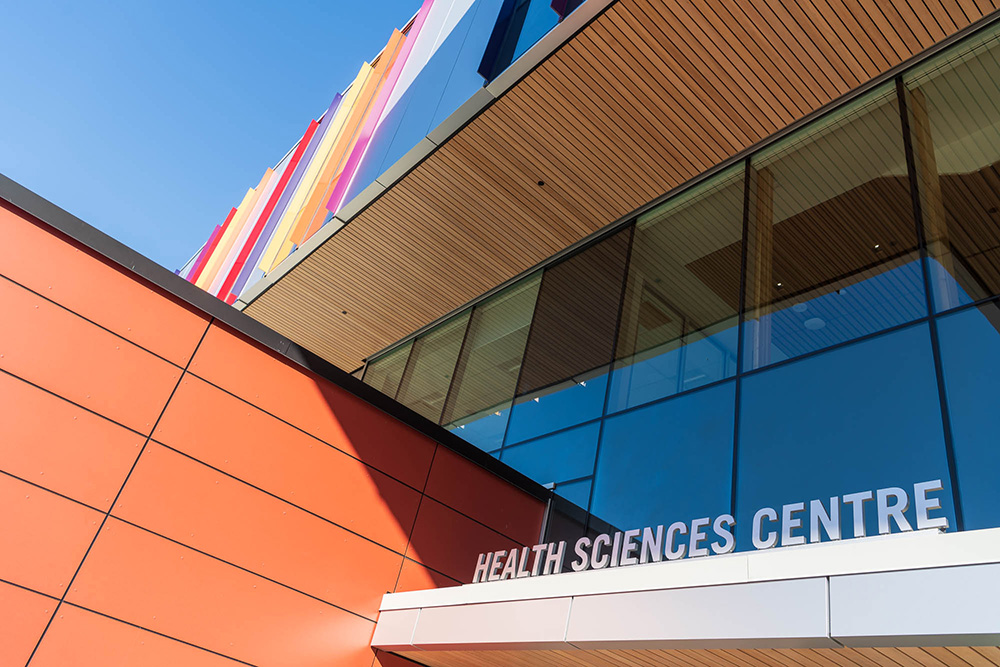Wellness is at the heart of the new BCIT Health Sciences Centre (HSC), reflected in healthy design features like lofty open spaces, and thoughtful details, all aimed at supporting education for healthcare professionals now — and in the future.
“It’s a beautiful environment for students to learn and for instructors to teach,” says the project’s architect, Eleonore Leclerc of Stantec. “We wanted to create a space that was versatile and would age well,” she says. “We’ve used a lot of references to natural materials and elements.”
The 111,460 square-feet building will be one of the largest hubs for healthcare simulation training in Canada, allowing students at the Burnaby Campus site to replicate a variety of hospital, community, home, and laboratory settings. This means the HSC design had to be highly adaptable and considered, in order to support students from different health-related programs often working collaboratively, like they would in the real world. In addition to state-of-the-art classrooms and lab spaces, the HSC also includes many flexible common areas to further encourage interaction as well as socializing outside of class, like multipurpose rooms and garden space.
“The social spaces and the public spaces in the building are generous. They feel large. They are bathed with natural light,” emphasizes Eleonore. “They feel healthy.” In fact, the HSC is built to WELL Building Gold Standard, an international designation that recognizes buildings that are thoughtful and enhance human health and wellbeing. It will also be certified by the Rick Hansen Foundation for accessibility. The HSC also includes many sustainable features, like an efficient heating and lighting system, bicycle storage and shower amenities to support those who bike, as well as 60 EV charging stalls — a project which received funding from Natural Resources Canada.
A collaborative approach to the building design
“There was a lot of input and collaboration involved in determining the final design,” says Eleonore, describing what she calls “superweeks” — where the team at Stantec received specific feedback and input from different programs, BCIT staff, instructors, and students.
“The building kept moving right until the end of design development,” reflects Eleonore. “We had the flexibility to continue and maintain that user engagement and to adapt and adjust space on further thoughts.”
For instance, there was an emphasis on showcasing learning and encouraging transparency within the overall design itself. The result includes windows to spaces like classrooms and labs, but also to places like mechanical rooms, so the actual internal workings of the building are visible along with study areas.
Feedback and consultation helped tackle practical issues too, like the need for more space around each bed to provide room for greater numbers of students to be on-site learning, as well as larger elevators to ensure they would fit an ICU bed and four people to move a patient to the OR during a simulation. There’s even a replica of an apartment to help students simulate caring for a patient in-home.
They also consulted with BCIT Indigenous Initiatives and Partnerships in the design, including Indigenous elements like a four-storey feature wall, as well as Indigenous Glazing Films on 62 windows on the southwest corner of the building overlooking the building’s stairs. And the rooftop garden includes materials and plants carefully selected to pay tribute to Indigenous culture and traditional use of medicinal plants.
This collaborative approach to the building’s design was intentional and impactful, notes senior project manager, Christie Paxton, BCIT Facilities and Campus Development.
“An important part of the Health Sciences Centre is interdisciplinary learning for healthcare students through fostering collaboration across all BCIT health programs, so it’s fitting that the design for the space itself came about through gathering feedback and input from many, many people — all working together,” says Christie.
“The result is a healthy, intelligent, and sustainable space for staff and students providing key, next-generation learning today and for years to come. It’s really wonderful to see it come together.”
The building will be welcoming students to study in the Fall of this year.
